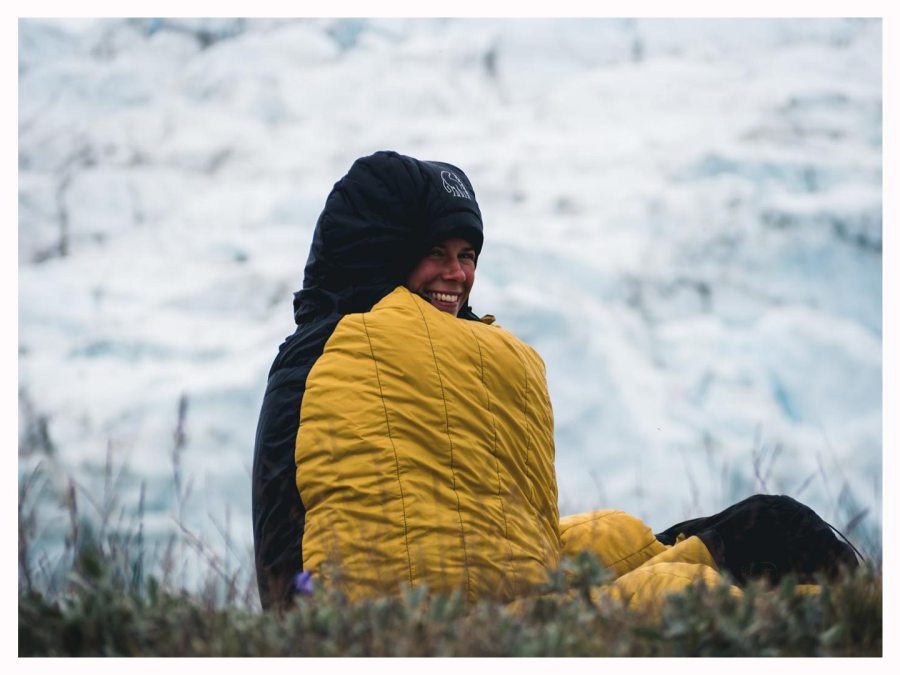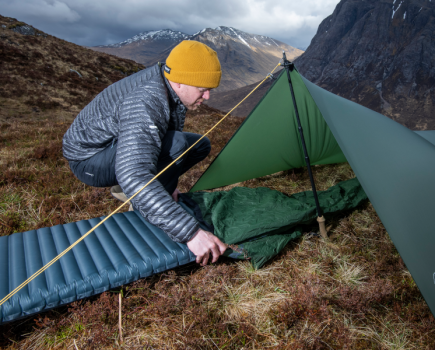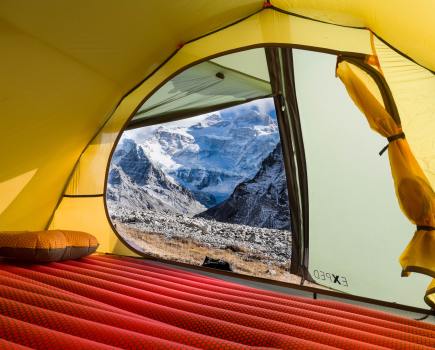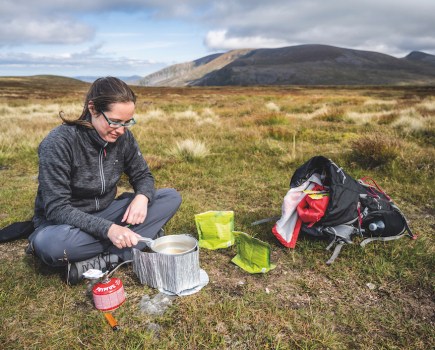Many of the best sleeping bags keep you warm by acting as insulation for the body and like almost all forms of insulation they work by trapping air. This trapped air is held close to the surface of the skin, where it is gradually warmed by your own body heat, forming an insulating barrier between your body and the colder outside air. It is the fluffy, lofty fill inside a sleeping bag that enables it to trap air. The fill is usually either synthetic insulation or natural down.
Different types of sleeping bag
Down sleeping bags
Down is nature’s best insulator. It is the fluffy under-plumage of ducks and geese. It offers excellent warmth for weight and is highly compressible. This makes it ideal for use in lightweight, packable sleeping bags. If looked after, it can last for many years. However, down has a couple of drawbacks. It is very expensive, and it loses its warmth when wet. That’s because the delicate down clusters can collapse when waterlogged, losing their ability to loft (trap air). As a natural product that comes from ducks and geese, down insulation also raises some ethical questions. When buying a down sleeping bag, you should check that the fill is responsibly sourced or certified.
Synthetic sleeping bags
Synthetic insulation is made of fine, fluffy polyester fibres. It doesn’t offer quite the same warmth for weight as premium down. So, although a synthetic sleeping bag can be keep you warm, it will be much bulkier than an equivalent down bag. However, it is cheaper than down, easier to look after, and provides warmth even when it’s wet. This is because polyester is hydrophobic – it has low moisture absorbency. It is ideal for camping in damp conditions. But synthetic insulation has disadvantages too. It is not as resistant to repeated compression cycles as down. Over time the fibres gradually break down and so do not loft as effectively.
Sleeping bag design
Other design factors affect the warmth of sleeping bags too, including their method of construction. Many synthetic bags use blanket or sheet insulation to reduce lines of stitching and minimise cold spots. Down, on the other hand, is a loose fill made up of down clusters and feathers. It must be contained inside baffles. The size, shape and arrangement of these baffles is key to keeping warm. Premium sleeping bags usually employ ‘box wall’ or trapezoid-shaped baffles, which reduce heat leakage via the seams. Other bags use multi-layer constructions, or place extra fill in specific zones around the body, such as the footbox. Again, this helps to prevent cold spots. Most premium bags also feature internal padded baffles at the neck or shoulder and behind the zipper to help lock in heat and prevent draughts.
Want to learn more about sleeping bags and how they work? Then check out How do sleeping bag ratings and temperatures work?
More sleeping bag content found here:

Written by Matt Jones
A highly experienced outdoors writer and editor, Matt Jones has been testing kit in the field for nearly a decade. Having worked for both the Ramblers and the Scouts, he knows one or two things about walking and camping, and loves all things adventure, particularly long-distance backpacking, wild camping and climbing mountains. He’s based in Snowdonia, the ideal backyard for testing outdoor kit to its limits.
Many of the best sleeping bags keep you warm by acting as insulation for the body and like almost all forms of insulation they work by trapping air. This trapped air is held close to the surface of the skin, where it is gradually warmed by your own body heat, forming an insulating barrier between your body and the colder outside air. It is the fluffy, lofty fill inside a sleeping bag that enables it to trap air. The fill is usually either synthetic insulation or natural down.
Different types of sleeping bag
Down sleeping bags
Down is nature’s best insulator. It is the fluffy under-plumage of ducks and geese. It offers excellent warmth for weight and is highly compressible. This makes it ideal for use in lightweight, packable sleeping bags. If looked after, it can last for many years. However, down has a couple of drawbacks. It is very expensive, and it loses its warmth when wet. That’s because the delicate down clusters can collapse when waterlogged, losing their ability to loft (trap air). As a natural product that comes from ducks and geese, down insulation also raises some ethical questions. When buying a down sleeping bag, you should check that the fill is responsibly sourced or certified.
Synthetic sleeping bags
Synthetic insulation is made of fine, fluffy polyester fibres. It doesn’t offer quite the same warmth for weight as premium down. So, although a synthetic sleeping bag can be keep you warm, it will be much bulkier than an equivalent down bag. However, it is cheaper than down, easier to look after, and provides warmth even when it’s wet. This is because polyester is hydrophobic – it has low moisture absorbency. It is ideal for camping in damp conditions. But synthetic insulation has disadvantages too. It is not as resistant to repeated compression cycles as down. Over time the fibres gradually break down and so do not loft as effectively.
Sleeping bag design
Other design factors affect the warmth of sleeping bags too, including their method of construction. Many synthetic bags use blanket or sheet insulation to reduce lines of stitching and minimise cold spots. Down, on the other hand, is a loose fill made up of down clusters and feathers. It must be contained inside baffles. The size, shape and arrangement of these baffles is key to keeping warm. Premium sleeping bags usually employ ‘box wall’ or trapezoid-shaped baffles, which reduce heat leakage via the seams. Other bags use multi-layer constructions, or place extra fill in specific zones around the body, such as the footbox. Again, this helps to prevent cold spots. Most premium bags also feature internal padded baffles at the neck or shoulder and behind the zipper to help lock in heat and prevent draughts.
Want to learn more about sleeping bags and how they work? Then check out How do sleeping bag ratings and temperatures work?
More sleeping bag content found here:
- What sleeping bag should I use for summer?
- Sleeping bags: What you need for summer and winter camping
- How do sleeping bags work?
- Are sleeping bags waterproof?

Written by Matt Jones
A highly experienced outdoors writer and editor, Matt Jones has been testing kit in the field for nearly a decade. Having worked for both the Ramblers and the Scouts, he knows one or two things about walking and camping, and loves all things adventure, particularly long-distance backpacking, wild camping and climbing mountains. He’s based in Snowdonia, the ideal backyard for testing outdoor kit to its limits







